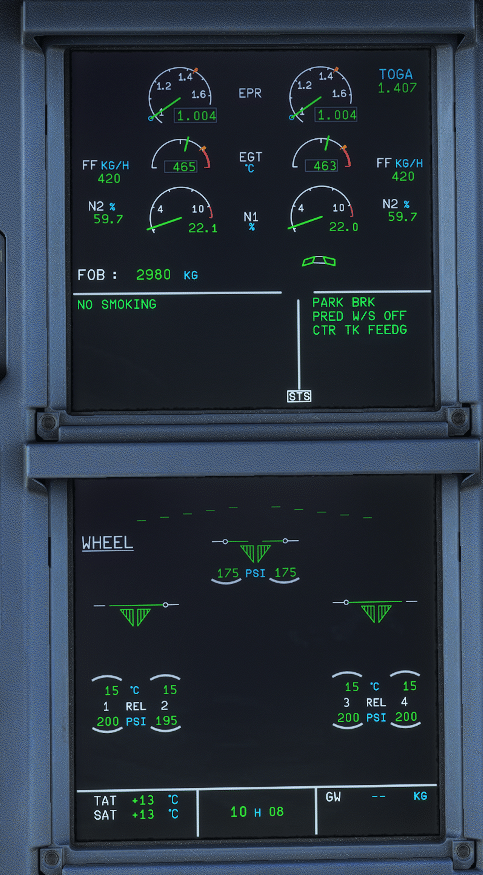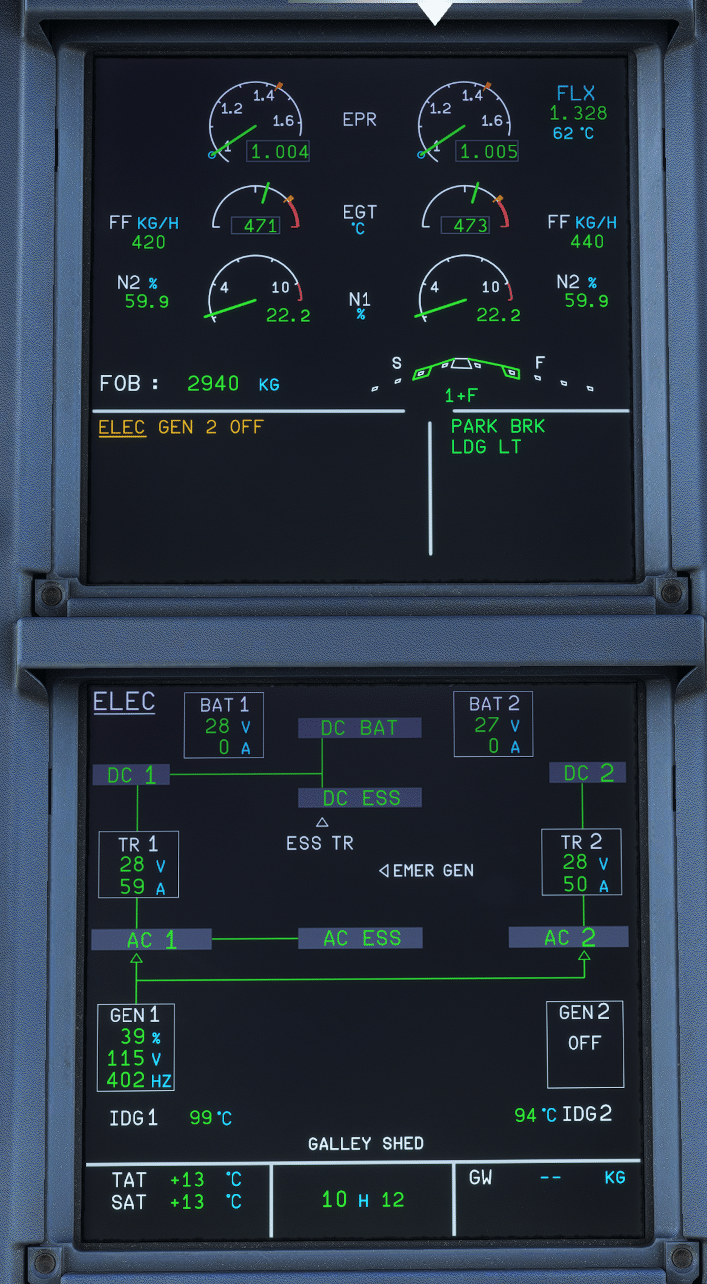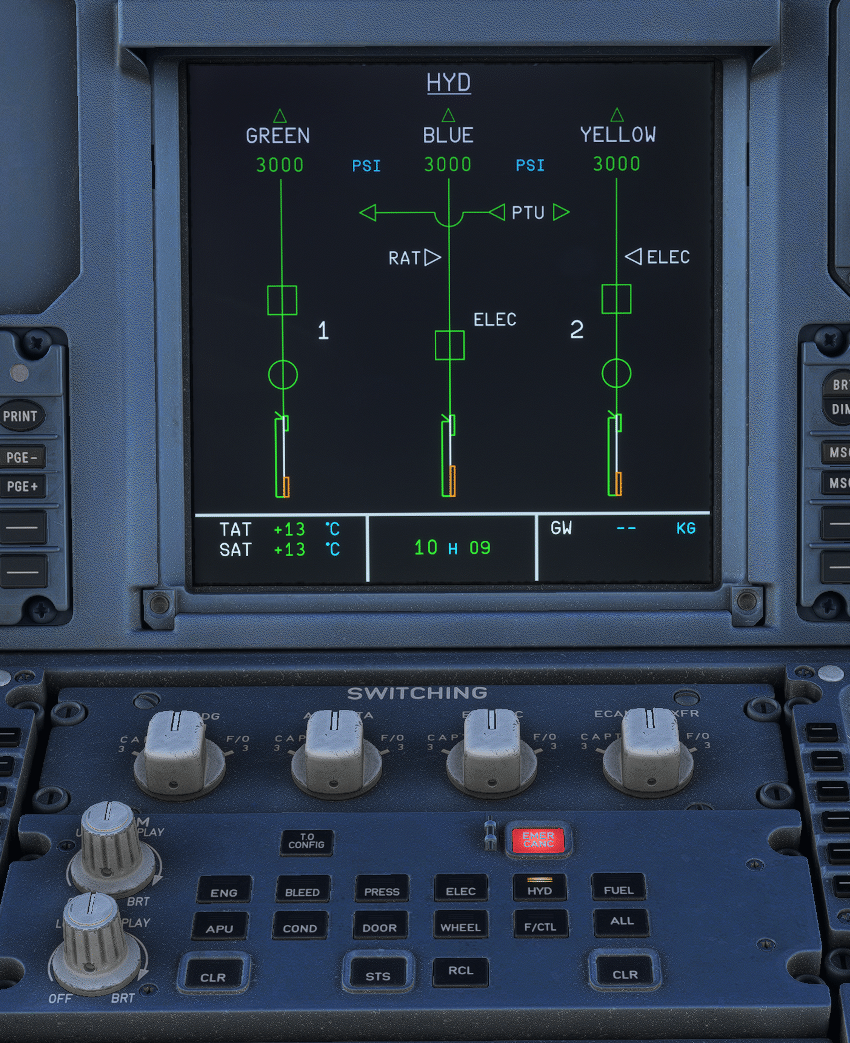If you’ve ever stepped into the flight deck of an Airbus A320, you’ve probably noticed the clean, digital layout, two large color displays that seem to quietly handle everything.
That’s ECAM, short for Electronic Centralized Aircraft Monitor, the system that revolutionized how pilots monitor and manage aircraft systems.
Built into every Airbus fly-by-wire jet since the A320, ECAM acts as the aircraft’s “information brain,” continuously checking system health, displaying key data, and guiding pilots through any abnormal situations.
The ECAM system provides critical information, including engine parameters and status pages, ensuring situational awareness throughout the flight.
Key Takeaways: Airbus ECAM
What Exactly Is ECAM?
In simple terms, ECAM is Airbus’ smart system for monitoring the aircraft. It watches over dozens of systems – from hydraulics and fuel to electrics and flight controls — and keeps the flight crew informed through two screens:
- E/WD (Engine/Warning Display) – The top screen showing engine data, warnings, and messages.
- SD (System Display) – The lower screen presenting system synoptic pages and aircraft status.
Together, they replace hundreds of analog gauges and paper checklists with something much smarter — a digital, prioritized, easy-to-read interface.

According to the Airbus A320 FCOM (Flight Crew Operating Manual, 11-Oct-2023), ECAM is part of the Electronic Instrument System (EIS), which combines both the EFIS (Electronic Flight Instrument System) and ECAM to present all critical information in one place.
Breaking Down the Airbus ECAM System
The ECAM is more than just two screens. It’s a network of computers and sensors that constantly communicate with one another to ensure nothing is overlooked.
| Component | Function |
|---|---|
| 2 Flight Warning Computers (FWCs) | Generate warnings, alerts, and aural messages. |
| 2 System Data Acquisition Concentrators (SDACs) | Collect data from all aircraft systems. |
| 3 Display Management Computers (DMCs) | Turn raw data into visuals on the screens. |
| ECAM Control Panel (ECP) | Lets pilots manually select system pages or review messages. |
| 2 Display Units (DUs) | The physical screens that show the E/WD and SD pages. |
Each of these units is redundant and interchangeable — meaning if one fails, another instantly takes over. Airbus designed ECAM this way to ensure no single failure can cause a loss of crucial flight information.
How ECAM Works in Flight
The logic behind ECAM is both simple and elegant. It continuously receives inputs from sensors across the aircraft — covering engines, hydraulics, electrical, pressurization, and more.
- ECAM detects the issue instantly.
- The E/WD presents a warning or caution, depending on severity.
- The system automatically calls up the relevant checklist or synoptic page.
- Once the issue is resolved, ECAM displays a STATUS page summarizing any residual effects.
This entire process happens in seconds, allowing the crew to act quickly and confidently.
Airbus calls this philosophy “monitor – manage – review.” It means pilots monitor the alert, manage the action, and review the aircraft’s condition before continuing.
ECAM Alert Levels Explained
Not all alerts are equal, and ECAM color codes them accordingly:
| Level | Color | Meaning | Pilot Action |
|---|---|---|---|
| Level 3 | Red | Warning – immediate action needed | Act now |
| Level 2 | Amber | Caution – action required | Do it soon |
| Level 1 | Amber/White | Advisory – for awareness | Monitor only |
| Level 0 | White | Information – no action needed | None |

To prevent overload, ECAM automatically inhibits certain alerts during critical phases like takeoff and landing, reducing distractions when pilots are busiest.
The System Display Pages (SD)
The System Display (SD) provides visual diagrams — or “synoptic pages” — for every major aircraft system:
- ENG: Engine parameters and indications
- HYD: Hydraulic systems (Green, Blue, Yellow)
- ELEC: Electrical generation and distribution
- FUEL: Fuel quantity, pumps, and crossfeed flow
- PRESS: Cabin pressurization and ventilation
- COND: Air conditioning and temperature control
- F/CTL: Flight control surfaces and actuator positions

These pages appear automatically when something requires attention or can be called manually using the ECAM Control Panel.
Built-In Redundancy and Reliability
According to the Airbus A320 Aircraft Flight Manual (AFM, 02-Apr-2025), ECAM is designed to remain fully functional even if parts of it fail.
- If a display screen fails, pilots can transfer ECAM to the Navigation Display using the ECAM/ND XFR switch.
- If one FWC or SDAC fails, the standby unit immediately takes over.
- With three Display Management Computers, ECAM can lose one and still function normally.
This triple redundancy is one reason Airbus aircraft are so trusted for their reliability and safety.
ECAM in Real-World Operations
Airbus pilots train extensively in ECAM management, following a precise procedure outlined in the Airbus FCTM (Flight Crew Techniques Manual, 23-Aug-2023):
- Monitor the message — understand the problem.
- Action the steps shown on ECAM.
- Review the STATUS page to confirm everything’s back to normal.
- Refer to the QRH (Quick Reference Handbook) if additional actions are required.
This ensures consistent, safe handling of every abnormal or emergency event.
ECAM vs Boeing EICAS
It’s often compared with Boeing’s EICAS (Engine Indicating and Crew Alerting System). While both systems share the same goal — keeping the crew informed — ECAM takes things a step further.
- ECAM automatically lists and tracks action items.
- Completed steps disappear from the screen in real time.
- A STATUS summary appears once the checklist is done.
Boeing’s EICAS typically requires pilots to cross-reference paper or electronic checklists. ECAM integrates it all into one intelligent interface — the ultimate example of Airbus’ “automation with control” design philosophy.
Why ECAM Matters
Beyond fault management, ECAM helps pilots operate the aircraft more efficiently. It’s part of a larger network that also includes:
- The Auto Flight System (ATA 22) – for autopilot and flight guidance.
- The Communication System (ATA 23) – for radio and interphone fault alerts.
- The Recording Systems (ATA 31) – which capture flight data for maintenance and analysis.
All of this integration makes ECAM a central hub for aircraft awareness — not just a warning system.
The next time you see an Airbus A320’s sleek glass cockpit, remember — ECAM is quietly doing what it does best: keeping the crew informed, the systems healthy, and the flight safe.
Related Reading
- Airbus A320 Auto Flight System Explained
- Understanding the A320 Flight Management System (FMGS)
- Airbus Communication System Overview
- Indicating & Recording Systems on the A320
Conclusion
The ECAM display presents alerts and indications, such as caution and warning displays, which are crucial for aviation safety. When an issue arises, like an engine failure or engine fire, the ECAM action prompts immediate action by the flight crew, ensuring that they adhere to the correct SOP and mitigate risks.
With its intuitive synoptic diagrams, the ECAM allows pilots to visualize the configuration of various aircraft systems. This includes detailed synoptic views for hydraulic, bleed air, and flight control systems, providing essential information to the pilots in critical phases of flight.
By utilizing ECAM handling, pilots can efficiently manage their workload, especially during critical phases of flight when quick decision-making is vital. The system’s indicating and crew alerting system enhances redundancy and reliability, ensuring that failures that require immediate attention are promptly detected and addressed.
In conclusion, the Airbus A320 ECAM is an indispensable tool in modern aviation, transforming cockpit operations by providing a comprehensive and efficient means of monitoring and managing aircraft systems, ultimately enhancing flight safety and operational efficiency.
Learn more about Airbus A320 Systems.
Frequently Asked Questions about Airbus ECAM
What does ECAM stand for and what is its purpose?
ECAM stands for Electronic Centralized Aircraft Monitor. It is an integrated monitoring and alerting system used on Airbus aircraft. ECAM automatically monitors aircraft systems, displays warnings or cautions, and guides pilots through corrective actions when a fault or abnormal situation occurs.
Which Airbus models use the ECAM system?
The ECAM system is standard on the Airbus A320-family (A318, A319, A320, A321) and also forms the foundation for ECAM implementations on newer Airbus aircraft such as the A330, A340, A350, and A380, although each has unique display layouts and enhancements.
What is the difference between the E/WD and SD displays on ECAM?
The E/WD (Engine/Warning Display) shows engine parameters, alert messages, and flight phase memos, while the SD (System Display) presents detailed system synoptic pages such as hydraulics, electrics, and fuel. The two work together to provide a complete systems overview.
How do pilots control or navigate ECAM pages?
Pilots use the ECAM Control Panel (ECP), located below the ECAM screens. It includes pushbuttons such as CLR, RCL, STS, ALL, and EMER CANC, as well as system page keys (ENG, BLEED, HYD, ELEC, etc.), allowing both automatic and manual page selection.
What do the ECAM warning colors mean?
ECAM uses standardized color coding to indicate priority and type of message:
- Red – Immediate warning, requires prompt crew action.
- Amber – Caution or non-urgent fault.
- White – Advisory or status information.
- Green – Normal indication.
- Blue – Checklist or procedural step.
What happens if an ECAM display screen fails?
If one ECAM screen fails, the system automatically reconfigures into single-display mode. ECAM data can also be transferred to another display using the ECAM/ND XFR switch. Essential ECP functions such as CLR, STS, and RCL remain available through hardwired redundancy.
How is ECAM different from Boeing’s EICAS?
Airbus’s ECAM not only alerts pilots but also provides step-by-step procedures and system guidance. Boeing’s EICAS (Engine-Indicating and Crew-Alerting System) primarily informs and alerts, leaving procedural references to the checklist. ECAM embodies Airbus’s “monitor, inform, and guide” design philosophy.

